
CS690 Cotton Stripper
- John Deere
- Agriculture
Find Your Nearest Location
Key Features & Specs
- Non-stop round module harvesting solution
- 13.5L Tier 4 engine with 530 peak horsepower
- ProDrive™ transmission with full-time 4WD
- 606SH or 608SH available headers

- + Expand All
- - Close All
-
More power to harvest in demanding conditions
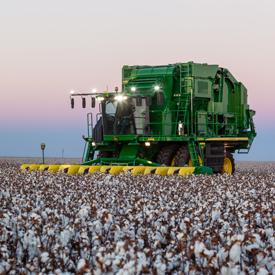 CS690
CS690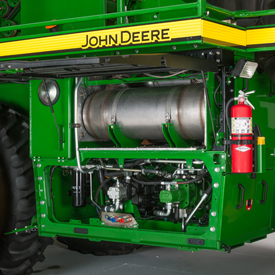 CS690 power module
CS690 power moduleThe CS690 Cotton Stripper is a powerful harvesting system - only from John Deere. With a 373 kW (500 hp), John Deere Final Tier 4 (FT4) 13.5-L PowerTech™ PSS engine, the CS690 packs enough punch to harvest in the most demanding conditions.
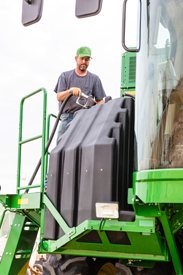 Fuel fill up
Fuel fill up
Many ask how frequently one must stop to fill up the CS690 with diesel fuel and the answer is simple - just once a day. And the 61-L (16-gal.) diesel exhaust fluid (DEF) tank will last much longer. The CS690 comes equipped with a 1022-L (270-gal.) fuel tank that allows the operator to fill up the tank while servicing the cotton stripper.
When it is time to move from one field to the next, the CS690 offers a transport configuration with a height of 4765 mm (187.5 in.). It moves from harvest mode to transport mode in roughly one minute and allows the operator to easily move down the road at 27 km/h (17 mph).
Whether trying to beat a rain coming in, harvesting in tough conditions, or simply moving from one field to the next, the CS690 provides power on which operators can depend. -
Round module moisture sensing ensures fiber quality
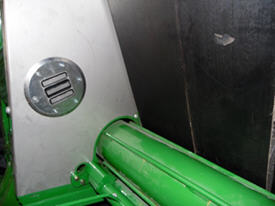 Moisture sensor
Moisture sensorThe moisture sensor on the CS690 Cotton Harvester provides on-the-go, real-time moisture measurement on which operators can rely. The moisture sensor is mounted on the round module builder which reads cotton moisture levels as the round module is being formed.
Customer value:
- Real-time data to help preserve cotton quality
- Module moisture documented in Harvest Identification, Cotton Pro
- Industry-leading accuracy in the critical 9–13 percent moisture range
Ginning value:
- Maximizes ginning efficiency through module moisture tracking
Theory of operation:
The moisture sensor continuously measures the moisture of seed cotton in contact with the moisture sensor during the round module forming process.
-
Round module weighing affords expanded capabilities

Round module weighing is standard on all CS690 Cotton Harvesters and provides real-time feedback on module weight during harvest. Operators will appreciate the added capabilities afforded by this system, such as easier yield monitor calibration. Round module weighing teamed with Harvest Identification, Cotton Pro provides the ginner with recorded module weights to be loaded into their system. Gins without scales will be able to use the module weights to provide turnout data to the producer.
Theory of operation:
Round module weighing process starts when the round module ejects from the module builder onto the handler. Once the handle automatically moves to the carry position the module weight is displayed on the CommandCenter™ display and displayed and documented in the GS3 2630 if the harvester is equipped with Harvest Identification, Cotton Pro.
-
Ginning advantages offered only by the CS690
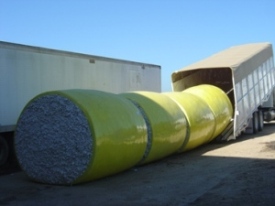 Module truck unloading round modules
Module truck unloading round modules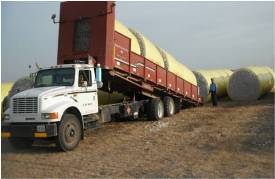 Loading round modules on gin yard
Loading round modules on gin yardThe CS690 Cotton Stripper also brings ginning advantages - only from John Deere.
The CS690 makes the ginning season easier for one of cotton farmers' most important production partners - ginners.
During the cotton ginning season, ginners are constantly on the go. They coordinate moving modules from fields to the gin yard. They manage the cotton entering the feeder floor and they keep the gin running should something break down. While doing all this, they still manage to gin 218-kg (480-lb) bales of cotton and place them securely in their warehouses, ready to go to a warehouse or mill. Clearly, being a ginner is hard work.
In the middle of the cotton harvest season, module trucks can run 24 hours a day trying to collect cotton modules that sit on turn rows. If rain is on the way, module truck drivers may need to change their scheduled routes and go to fields that could be impassable after a deluge to ensure the cotton makes it to the gin yard. Damaged traditional modules from wind can also quickly change pickup priorities.
Farmers who use traditional modules have only one option to get their cotton to the gin - the traditional module truck. However, farmers who generate round modules from their CS690 can move round modules with increased flexibility by two methods.
The Frontier™ Round Module Handler allows staging during or after harvest wherever is most convenient or ideal for pick up. After staging, round modules can be moved from the field by standard module trucks (after the inner six chains are changed) or flatbed semi-trailers. Four round modules fit easily in a standard module truck, whereas a 14.6-m (48-ft) flatbed trailer can haul six round modules, and a 16.2-m (53-ft) flatbed trailer can transport seven round modules at a time. Ginners and their module truck drivers can count on increased transportation flexibility when round modules are ginned at their facilities.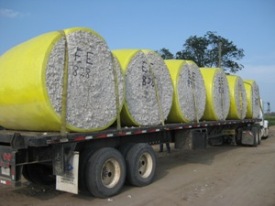 Flatbed trailer with round modules
Flatbed trailer with round modules Gin yard (wet modules)
Gin yard (wet modules)Increased flexibility in moving modules from the field to the gin yard is only the beginning of a long list of benefits ginners gain with round modules. Round modules are fully wrapped, minimizing the amount of lost cotton in the field or at the gin yard. For a gin ginning round modules, there is no need for a cleanup crew since there is no lost cotton on the ground. Conventional modules sitting on the ground have the opportunity to wick water off the ground, whereas the fully-wrapped modules keep cotton dry — from the field, to the gin yard, to the gin.
One ginner in a coastal south Texas community had to deal with a very large obstacle during a past cotton harvest: Hurricane Dolly. He recalled, We had 25 cm (10 in.) to 30 cm (12 in.) of rain across a 10-day period. We ginned round bales in the daytime and the conventional cotton in the evenings. During that period, we measured the amount of gas we were using on both of these, and we had about a 40 percent savings on gas [with the round modules].
For ginners, that amount of savings can help maintain a gin's profitability. Drier cotton in round modules compared to conventional modules was not a unique occurrence. Gin studies conducted throughout the south found that cotton in round modules received better grades and was significantly drier than that stored in traditionally-shaped modules.
A similar story comes from North Carolina, where both round and conventional modules were picked from the same field on the same day. The modules were brought to the gin and over the next 20-day period, both sets of modules received over 279 mm (11 in.) of rain.
It was decided to gin the conventional modules first. The bottoms were skimmed and wet spots were gutted from the modules. After finally getting them to the feed floor, the moisture within a given module ranged from 6 percent to 16 percent. The gin had to significantly turn down the feed rate and turn up the dryer. Finding the right feed and dryer rate was a continuous battle that resulted in a compromised feed rate.
When the round modules were run, module moisture consistency was around 8.5 percent. The gin was able to increase the feed rate to approximately seven bales per hour on average and significantly turn down the burner. The chance of over-drying and associated grade degradation was also reduced because of the constant feed and burner rate.
Reduced static electricity was another advantage seen in some locations. Cotton from round modules tends to flow through the gin easier than cotton from conventional modules due to reduced static electricity. Ginning records have been set when running round modules, partly due to the improved flow through the gin.
Ginners have reported positive results when ginning round modules. They have found the compact, round module design helps reduce cotton loss and quality degradation. The highly engineered wrap provides weather- and element-resistant round modules that preserve the quality of fiber and seed delivered to the gin.
Overall, ginners are pleased with the consistent module size, shape, and reduced moisture levels that facilitate increased throughput at the gin. In addition, the fully recyclable wrap may be sold to recyclers in the area, an extra income for the gin.
At the end of the day, round modules translate to more money in everyone's pockets. -
Simpler, more productive harvest with less labor
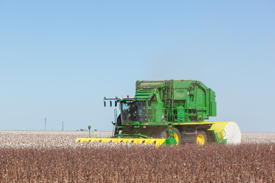 CS690 Cotton Stripper
CS690 Cotton Stripper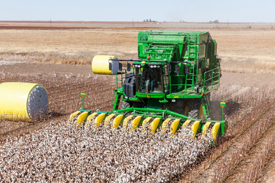 CS690 Cotton Stripper with round modules
CS690 Cotton Stripper with round modulesThe CS690 introduces true non-stop harvesting technology to the cotton stripper for increased productivity. Unlike traditional basket strippers, the CS690 provides its own onboard module building system, thereby eliminating boll buggy drivers, module builder operators, and all the supporting equipment traditionally needed during cotton harvest.
One Floydada, TX grower explained, "(The CS690) gives us an opportunity to reduce our labor, it gives us a more efficient way of handling and storing our cotton, and the non-stop harvest means your efficiencies go way up."
Increased productivity
The non-stop harvesting of cotton is achieved through the use of a high-volume accumulator, round module builder, and round module handler. The accumulator collects cotton while a formed round module is wrapped with a protective film and ejected onto the machine's rear handler. The handler allows a completed round module to be carried to the end of the row.
Since round modules are formed, ejected, and can be off-loaded while the CS690 is still harvesting, the operator can remain on the row instead of unloading or waiting to unload cotton into boll buggies or module builders.
Reduction of labor
We understand it can be difficult acquiring good labor to be able to keep multiple cotton strippers, boll buggies, and module builders up and running. With the CS690, harvesting cotton simply requires one operator per machine, and one tractor operator to stage modules for transport. Additionally, since each round module is wrapped with a protective film, they do not require the application of a module tarp for field storage protection. The CS690 helps reduce the risks associated with finding labor, enabling producers to have more efficient and less labor intensive harvesting operations.
A cotton harvesting veteran in the Ropesville, TX area stated, "The non-stop harvesting is what makes the CS690 what it is. Being able to harvest cotton with one individual doing the same thing that nine or 10 people were doing previously."
Reduction of support equipment
Typically each basket-style stripper requires a fleet of support equipment to achieve maximum harvest productivity:
- Boll buggy
- Boll buggy tractor
- Module builder
- Module builder tractor
- The CS690 requires only two pieces of support equipment:
- Frontier™ CM1100 Cotton Module Handler (or equivalent)
- 8000 Series (or equivalent) Row-Crop Tractor
These two pieces of equipment are used to stage round modules end-to-end in groups of four, so they may be picked up by a module truck. Producers and ginners also have the flexibility to haul the round modules on flatbed trailers, providing the opportunity to haul more pounds per load for reduced transport costs. Since modules can be staged any time, day or night, one tractor and CM1100 Cotton Module Handler can support multiple CS690 Cotton Strippers.
This reduction in support equipment means less equipment and traffic in the field and less fuel consumption. The CS690 not only creates a simplified harvest scheme, it helps reduce frustration that producers face while having to contend with traffic on increasingly busy roads.
-
Conserve fiber quality with 360 degrees of protection
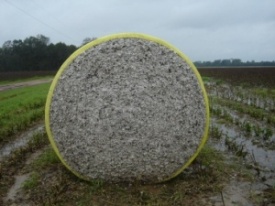 Round module
Round module Conventional module
Conventional moduleThe CS690 Cotton Stripper provides weather resilience for harvested cotton – only from John Deere.
A combination of high winds and rain can damage cotton whether in the field or at gin yards. With the fixed, 2.44-m (8-ft) wide round modules, producers and ginners receive 360 degree of protection, creating a unique shape that keeps cotton from blowing away and from wicking moisture that can reduce crop quality.
Modules are wrapped three times within the CS690’s on-board module builder, ensuring cotton fiber and seed protection. Each portion of wrap contains two segments of linear low-density polyethylene (LLDPE) film. A non-tacky layer is followed by two tacky layers to keep the round modules in a uniform shape and provide protection from wind, dust, and rain.
The Z-Lock™ dual tail-adhesive system ensures the tapered end of the wrap is secure in high winds and rain and that the next portion is ready for wrapping the next module.
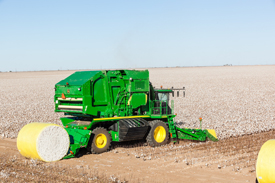 CS690 Cotton Stripper
CS690 Cotton Stripper
Producers who have round modules on their farms are impressed by the round modules' ability to preserve the cotton fiber and quality. One south Texas coastal producer harvested his entire south Texas cotton crop with 7760 Cotton Pickers. He shared, “The regular modules always have a bale or two on each end that will be a grade difference in color, and they also lose sometimes 10 to 15 percent of the cotton down on the ground. If you have got 25 cm (10 in.) to 30 cm (12 in.) of rain on the regular module, the module trucks just have to shave it off. And that cotton is still sitting out on the gin yard when the ginning is over; it is hard to determine how much we actually lost. In our round modules, we had zero loss this year.”
The CS690 now offers that same preservation capability for the cotton stripper producer.
With no lost cotton, this producer was able to harvest his entire crop and have it arrive at the gin feeder floor, ready to be ginned. No other cotton harvesting system available on the market today can deliver a producer's crop from the field to the gin floor.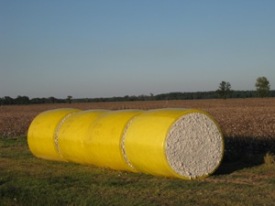 Round modules waiting to be loaded
Round modules waiting to be loaded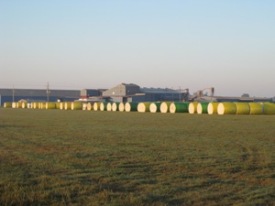 Gin yard
Gin yardProducers are not the only ones who see benefits in weather resilience with round modules; ginners are also enjoying the benefits. A ginner in North Carolina with much experience ginning cotton, both round and traditional modules, shared the following observation, “Once the cotton is in these round modules, it is safe. You do not have to worry about weather. You do not have to worry about time. It seems like the longer they stay in there, the better they gin.”
Z-Lock is a trademark of Tama Plastic Industry.
Dimensions
| Lengths | Overall length 1102 cm 434 in.Wheelbase 432 cm 170 in. |
| Heights | Full height position 477 cm 188 in. |
Power train
| Transmission | Gears Two range1st gear 0-8.1 km/h 0-5 mph2nd gear 0-14.5 km/h 0-9 mph ProDrive? automatic-shift (AST) |
| Hydrostatic system | Type Hydrostatic/mechanical drive |
| Engine | Horsepower 500 hpPower boost 30 hpDisplacement 13.5 L 824 cu in.Turbocharged/aftercooled YesAlternator Dual 200 amp John Deere PowerTech PSS? 6135HN005 |
| Fuel system | Type Electronic unit direct injectionOn-board diagnostics Yes |
| Cooling system | Rotary screen YesGround-level access to coolers Yes |
| Tires | Standard drive tire 520/85R42 (20.8R42) R1WStandard steering tire IF580/80R34 R1W |
| Brakes | Wet, multiple disk |
Row units
| Tank capacities | Fuel tank 1022 L 270 gal. |
| Configurations | Number of rows 6 or 8Spacings 76 cm 30 in. 91 cm 36 in. 97 cm 38 in. 102 cm 40 in. 606SH and 608SH |
| Row guidance | Manual RowSense? system / AutoTrac? RowSense? system |
| Stripping units | Style Bat/brush stripping unitsUnit drive protection Slip clutch ? one per unit |
| On-board cleaner | Type Two drumDrum diameter 337 mm 13.25 in.Bypass system Yes Yes |
| Hydraulic system | Pump type Pressure/ flow compensatedPressure 210 bar 3050 psiFlow 223 L/min 59 gpm |





